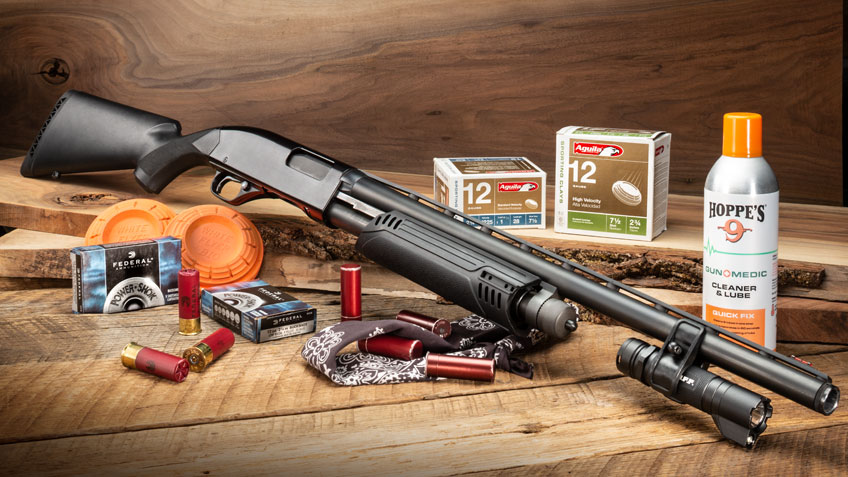
Just because your name isn’t “Shotgun Eddie” and you didn’t ride a stagecoach to San Antone in your formative years doesn’t mean you can’t defend your home adequately with little more than a loaded shotgun and the will to use it. Of course, advanced training is always best, but if you haven’t the time for it, at least practice the following Seven Cardinal Rules, and you’ll be fairly well prepared to rid your home of evildoers.
Break-in New Shotguns
Even the best semi-automatic shotguns on the market need a couple hundred rounds fired through them to reach their reliability potential. Mass manufacturing, even as good as it is these days, leaves rough edges between moving parts that will naturally hone themselves during the friction of normal fire. So, don’t go into a gun battle with a “green” gun.
Keep Your Shotgun Clean and Lubed
One time I entered a three-gun tournament and stupidly pulled my new Remington Versa-Max Tactical out of the box the night before the match. It was, of course, pristinely clean, but what I failed to notice was that the gun was as dry as a homecoming ball in the Bible Belt. During the first stage, I discovered I was essentially shooting a single shot—that is until some kind competitor loaned me a can of Rem Oil. The shotgun hasn’t jammed since.
Other guys shoot their guns and fail to clean them. In most cases, a little residue is fine, but combine that with some old gummy oil, a little lint, dog hair and maybe some specks of rust and suddenly you’ve got a recipe for jam—and not the strawberry kind.
This is the tool that you’re betting your family’s well-being on, and one that likely spends 99 percent of its time in your house. There’s no excuse for not keeping it properly lubricated and running like a finely tuned machine at all times.
Put a No-Nonsense, Full-Size Buttstock on Your Shotgun
Shotguns require both hands to shoot accurately and their intense recoil is best handled if the shooter maintains four solid points of contact—shoulder, cheek and each hand—to control it and shoot fast and accurate shots. Shotguns were developed in England several centuries ago, and these folks figured out how best to shoot them, and that was with a buttstock that aligns the hands, head and eyes down the barrel so patterns go where the shooter looks without much conscious thought. Don’t ruin all this with a pistol grip or some type of skeletonized metal tube stock that will batter you without giving you anything in return. Buy a gun with a good stock and grip that thing well.
Use Full-Power, 00-Buck Loads Through a Cylinder Bore
Of course, there might be some situations where birdshot, No. 4 buck or slugs are best, but generally 00 buck is best due to its nine to 15 .33-caliber pellets that will stop any human-size target it hits out to about 40 yards. Through a cylinder bore, it will spread at roughly the rate of 1 inch per yard, which is about the width of a human’s vital zone at 10 yards. While birdshot may not penetrate house walls, you might need it to penetrate something at some point, and it may not reliably cycle your semi-automatic shotgun. Lastly, unless you’re shooting a pump, be careful about using reduced-recoil loads in your home-defense gun unless you’ve tested them extensively; they can also fail to cycle the actions of certain semi-automatics. Meanwhile, 00 buck just works.
Put a Light on It
While I’m not a big proponent of hanging a slew of clanky gimmicks from my work-horse gun, a flashlight isn’t a gimmick. Fact is, criminal creatures often operate during nighttime, and the shotgun is so heavy when loaded that few of us can adequately control it with one hand while holding a flashlight with the other. Target ID is paramount. The best solution is to mount a flashlight on your shotgun. While SureFire’s DSF-series light that replaces the entire stock assembly is the best product going, even a $20 Picatinny mount that secures any light to your scattergun is much better than nothing. Bite the bullet and buy a light for your home-defense shotgun.
Learn to Operate the Gun and its Controls Blindfolded
Each shotgun requires some time learning to load the magazine, work the bolt, find the action-release button and safety. You should know how to manipulate all of them—loading, firing and correcting jams—even in pitch-black darkness. All this takes is repetition, and closing your eyes while you practice loading, working the action and unloading it will speed the muscle-memory process. Then, when the lights are on or the blindfold’s off, your shotgun will be that much more familiar to you.
Practice as Much as you Reasonably Can
This is true for any defensive firearm, but even more so for the scattergun. Even if it’s shooting clay games or stationary targets with birdshot on a pond dam, before you know it, you’ll master the gun’s feel, idiosyncrasies, shortcuts and where its pattern prints in relation to where you hold the bead. As a byproduct, you’ll learn to work out jams and then reload the gun quickly. Just shooting a few boxes of shells through your home-defense gun on a couple of separate occasions to gain familiarity is probably the most-important cardinal rule of all.





































